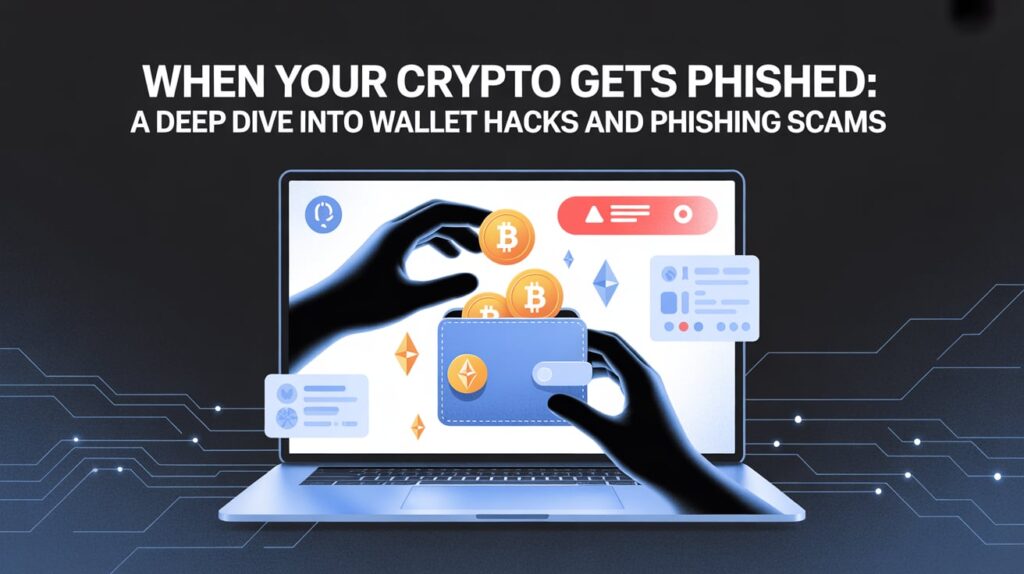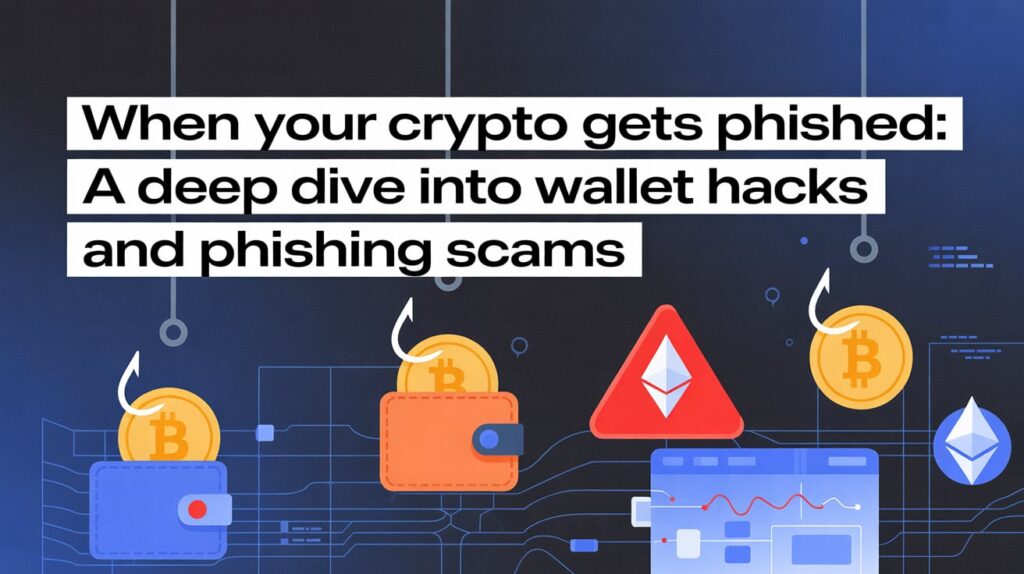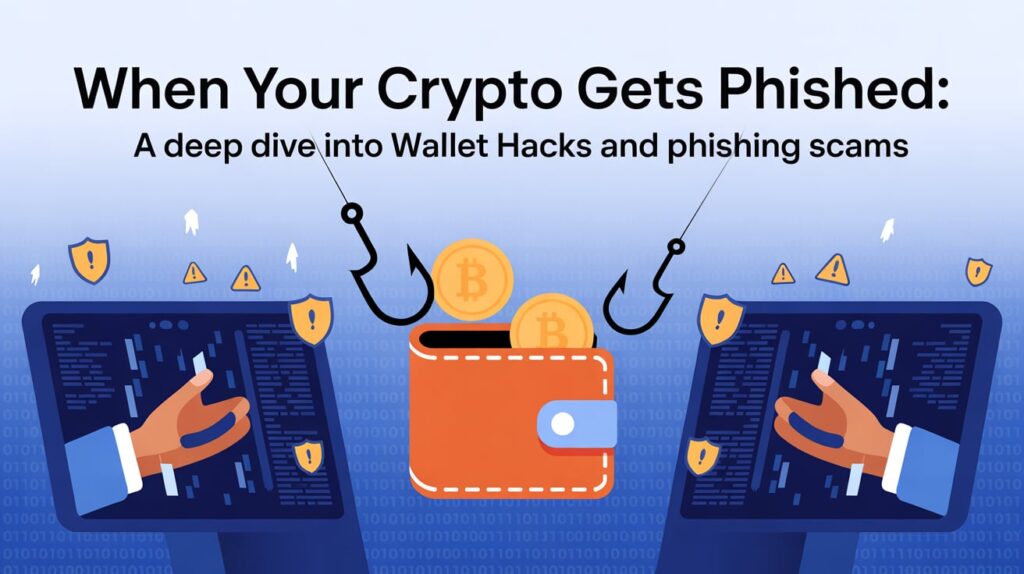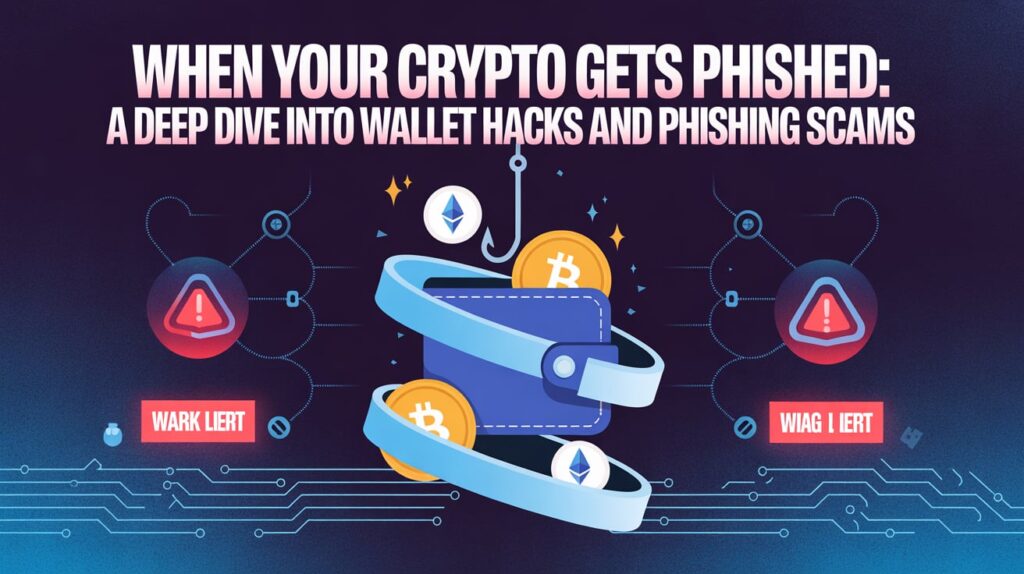When Your Crypto Gets Phished: A Deep Dive into Wallet Hacks and Phishing Scams
You might think your crypto wallet is safe—cold storage, hardware wallets, secure passwords. But here’s the harsh reality: in the world of digital assets, the weakest link is often human. The combination of clever phishing attacks and sophisticated wallet-hacks means that even experienced users are vulnerable.
In 2025, the line between an ordinary email and a catastrophic loss has become razor thin. Hackers are no longer simply looking for weak passwords—they’re infiltrating browsers, intercepting hardware wallet flows, creating lookalike addresses, and using social-engineering that would fool many. The question isn’t if you could be targeted—it’s when.
This article walks you through:
-
What crypto phishing and wallet hacks look like today
-
Where the vulnerabilities lie (technical + human)
-
Real-world case studies and what we’ve learned
-
Practical steps you can use to defend yourself
-
What the future holds for wallet security
By the end, you’ll have a clearer understanding of the risks—and a tangible checklist to reduce those risks.
Chapter 1: Understanding Crypto Phishing & Wallet Hacks
1.1 What is Crypto Phishing?
Phishing in the cryptocurrency space takes familiar forms (fake emails, malicious links) but also more advanced methods:
-
Scams that impersonate trusted crypto projects, wallets or exchanges.
-
Interfaces that mimic genuine wallet UIs and trick users into signing malicious transactions.
-
“Drainer” tools: malicious scripts that, once you give permission, drain your wallet automatically. Group-IB+1
-
Lookalike wallet addresses and impersonated smart contracts that trick users into sending funds to the wrong address. arXiv
1.2 What is a Wallet Hack?
“Wallet hack” is a broad term—but here it covers unauthorized access or manipulation of your cryptocurrency wallet or keys. Examples include:
-
Private key leaks or malware that exposes keys.
-
Exploits of hardware wallet address‐verification weaknesses. arXiv
-
Security breaches at centralized exchanges or hot-wallet services. Webopedia+1
-
Social engineering attacks that trick authorised users into approving transactions.
1.3 Why This Happens (And Why It’s Hard to Stop)
-
Crypto is inherently irreversible: once funds exit your wallet, getting them back is extremely difficult.
-
Unlike banks, most crypto infrastructure lacks the same regulatory protections or fraud reversal mechanisms.
-
Attackers exploit both technical weaknesses (e.g., smart contract bugs, wallet UIs) and human weaknesses (trust, haste, impersonation).
-
The pace of innovation in crypto means security often lags behind clever new hacking techniques.
Chapter 2: Anatomy of a Phishing + Wallet Hack Attack
Let’s walk through a common scenario step-by-step so you can recognise it next time.
2.1 The Setup
-
You receive an email or social media DM claiming to be from a wallet provider, exchange, or airdrop event.
-
The message includes a sense of urgency: “Claim your free tokens!”, “Your wallet access will be suspended unless you login”, or “We need you to approve this contract.”
-
You click a link (looks legit) and sign in or connect your wallet.
2.2 The Hook
Once you connect or approve—either:
-
You unknowingly grant permission for a malicious smart-contract to spend your tokens.
-
Or you give access to your private key/recovery phrase via a malicious site or app.
2.3 The Drain
-
The malicious contract uses permissions to transfer your tokens.
-
Your wallet drains—either gradually or all at once. Tools called “wallet drainers” are used. Group-IB+1
-
Often funds are laundered using bridges, mixers, cross-chain transfers to obscure the trail. CCN.com
2.4 The Cleanup (and Your Shock)
-
You realise you’ve lost funds; there’s no “undo”.
-
You review logs and see unfamiliar contracts or transfers.
-
You wonder: “How did I fall for this?”
Understanding this flow helps you interrupt the chain at “connection” or “approval” stage so you never get to the “drain”.
Chapter 3: Notable Real-World Hacks and What They Reveal

3.1 Wallet Draining Techniques & DeFi Exploits
In 2025, we’ve seen phishing plus wallet hacks contributing to major losses. For instance:
-
A full list of hacks/scams in 2025 highlights how social-engineering and wallet access continue to dominate. CCN.com
-
Crypto wallet drainers: tools specifically designed to impersonate legitimate services and trick users into signing away funds. Group-IB+1
3.2 Address-Poisoning & Lookalike Attacks
Researchers found that “address poisoning”—sending tiny “dust” or fake tokens to victims, then later tricking them into sending funds to the lookalike address—accounted for Millions of USD in losses. arXiv
3.3 Hardware Wallet Vulnerabilities
Even hardware wallets aren’t immune. One academic paper documented a “clipboard meddling” hack (EthClipper) that replaced the recipient address in the clipboard so victims send funds to attacker’s address. arXiv
3.4 Centralised Exchange Breaches
It’s not just user wallets. The major hack of Bybit in early 2025 (~US$1.4 billion) included cold wallet compromise and sophisticated phishing tactics. MarketWatch+1
Although that’s an exchange hack, it underscores how wallet security, human error and access control all matter.
Chapter 4: Why India (And You) Should Care
Even if you’re based in Surat, Gujarat (or anywhere in India), this isn’t just a distant threat.
4.1 Rapid Crypto Adoption + Less Mature Infrastructure
India’s crypto adoption has grown rapidly. With that comes increased risk: less mature regulatory oversight, fewer norms for wallet providers, and, for many users, limited exposure to advanced wallet-security best practices.
4.2 Social Engineering Works Across Languages & Platforms
Phishing campaigns sometimes localise their content: Indian users may receive messages in Hindi, Gujarati or via WhatsApp groups, creating a sense of trust. Attackers target both the global and local user base.
4.3 Cross-Border Laundering Hides the Trail
Even if you’re in India, the stolen funds often traverse global bridges. Tracking becomes harder, meaning local law-enforcement and regulators face challenges in recovery.
4.4 Cultural Factors + Risk Behaviour
Many retail investors may be less familiar with wallet permissions, contract approvals, gas fees, or the necessity of verifying contract addresses. This knowledge gap increases vulnerability.
Chapter 5: Practical Defence—How to Protect Your Wallet and Assets

Here’s your actionable checklist to reduce risk significantly.
5.1 Use Hardware Wallets (and Use Them Properly)
-
Keep private keys/recovery phrases offline.
-
Always verify recipient address on the device display when sending assets (hardware wallets show the address).
-
Update firmware regularly and only via official sources.
5.2 Wallet Permissions & Smart-Contract Approvals
-
Before connecting your wallet to a website, check: Is this site legitimate? Domain spelling? SSL certificate?
-
Revoke unnecessary approvals: Use tools (e.g., Etherscan or BSCScan “Token Approvals” pages) to check which contracts can spend your tokens.
-
When asked to “approve” a contract, ask: Why does it need this permission? If unclear—decline.
5.3 Beware of Phishing Links & Social Engineering
-
Don’t click links in unsolicited emails/DMs.
-
Double check sender identity, domain name, and context. Look for red flags: urgency, typos, ambiguous promises.
-
Never divulge your seed phrase or private key—no legitimate service will ask for it.
-
Use 2-FA (two-factor authentication) where possible, and keep your device software updated.
5.4 Manage Risk Exposure
-
Keep only the assets you actively need in “hot wallets” (connected to the internet). Store the rest in cold storage.
-
Diversify: don’t keep all assets in one wallet/platform.
-
Maintain records of transactions and wallet addresses in case you need to trace or report a loss.
5.5 Use Monitoring and Alerts
-
Set alerts for large transfers from your wallet.
-
Consider address monitoring services that notify you of suspicious activity.
-
Review blockchain activity regularly if you hold significant tokens.
5.6 Recovering from a Loss (If It Happens)
-
Report the incident to your local regulator and platform (if applicable).
-
Document all evidence: timestamps, addresses, links, screenshots.
-
Engage blockchain analysts if possible—it may be possible to trace funds.
-
Consider legal assistance (especially for large losses) and reach out to the community for shared intelligence.
Chapter 6: The Hidden Signals — What Hackers Exploit Next
Understanding what’s next helps you stay ahead of the curve.
6.1 Smart-Contract Phishing & Payload Attacks
Research shows a new class of attacks on Ethereum, called Payload-Based Transaction Phishing (PTXPHISH), where users approve what appears to be a normal transaction—but a malicious payload executes instead. arXiv
These are harder to spot because they use legitimate UI cues but malicious logic.
6.2 Address Poisoning & Lookalike Attacks
Attackers generate addresses visually similar to those you’ve used before (or expect), then trick you into sending funds to them via your wallets’ dropdown/autocomplete. The 2025 study found millions of attempts and tens of millions of dollars lost. arXiv
6.3 Supply-Chain & Developer-Targeted Attacks
Hardware wallet and wallet-software developers themselves become targets. Example: An npm-GitHub compromise distributed malicious Javascript packages that targeted crypto wallets. ReversingLabs
This means even if the wallet is secure, your environment (dev tools, libraries) might not be.
6.4 Social Media & Impersonation Campaigns
Influencers’ accounts or brand pages get hacked and used to promote fake token drops/wallet connect prompts. Users trust the brand, click the link, connect wallet—boom. Example: UFC’s Instagram hack in which a crypto-scam post went out via their official account. New York Post
Chapter 7: Building a Security Mindset—Why It Matters

Security isn’t just about devices—it’s a mindset.
-
Assume you will be targeted. If you treat your wallet like it can’t be hacked, you may be in denial.
-
Pause before you click. A moment of verification can save thousands.
-
Understand what you’re authorising. Not just “approve” but why.
-
Learn from incidents: Many hacks are not novel—they reuse known patterns.
-
Treat your wallet like a bank vault: You wouldn’t leave your bank card unlocked in public—why treat crypto differently?
Chapter 8: What This Means for the Crypto Industry
8.1 Trust & Adoption Hang in the Balance
Large hacks and phishing campaigns erode trust. For crypto to gain wider adoption, security incidents must diminish and user safeguards must improve.
8.2 Regulation and Self-Regulation
Governments and regulators increasingly require stronger safeguards for wallet services, exchanges and crypto infrastructure. To avoid regulatory backlash, the industry needs stronger security standards.
8.3 Educating the Next Billion Users
As more retail participants enter crypto (especially in countries like India), the education gap widens. Security literacy will be as important as understanding “what is Bitcoin”.
8.4 Innovation in Security Tools
We’ll see growth in:
-
Wallets with stronger UI/UX to prevent accidental approvals
-
On-chain monitoring tools for wallet behaviour
-
Attack-detection systems tailored for Web3
-
Recovery protocols and perhaps insurance products for crypto asset losses
Chapter 9: Your 30-Point Checklist (Before You Connect Wallets)
Here’s a condensed checklist you can print, paste beside your setup, or use as a routine before engaging with wallets or Web3 apps:
-
Verify domain spelling of site you’re connecting to
-
Use browser extension blocklists for known phishing sites
-
Use hardware wallet for large funds
-
Update wallet firmware and software
-
Use unique strong passwords and 2FA
-
Store recovery phrase offline, in safe location
-
Do not share private key or recovery phrase with anyone
-
Revoke old approvals via token-spend checkers
-
Before clicking “Approve”, ask: What is this permission doing?
-
Check recipient address manually when sending funds
-
Avoid using public WiFi for wallet access
-
Use a dedicated browser or device for Web3 interactions
-
Keep small “hot wallet” balance for daily use; store rest cold
-
Enable notifications/alerts for large wallet transfers
-
Regularly compile and backup your wallet transaction history
-
Consider multi-signature wallet for critical funds
-
Understand which tokens or chains you’re trusting
-
Never click links from unsolicited messages promoting “free tokens”
-
When in doubt—exit and research more
-
Store seed/recovery phrase in fire-safe or safe deposit box
-
Use hardware wallet address display for verification
-
Don’t let “FOMO” rush you into approving contract interactions
-
Educate friends/family about wallet safety (you’re a link in their chain too)
-
Monitor for “dust” (tiny token deposits you didn’t expect) — could be address poisoning. Wikipedia+1
-
If using mobile wallet, ensure OS and apps are up to date
-
Use trusted wallet providers with strong reputations
-
Review app permissions on mobile—avoid granting broad access
-
Beware of “wallet connect” screens — make sure you recognise the app requesting connection
-
Stay informed about current phishing techniques & scams
-
If you lose funds, immediately cease activity, collect evidence, inform exchange/regulator
Chapter 10: Final Thoughts—Stay Vigilant, Stay Prepared
Phishing and wallet hacks will not vanish anytime soon. As crypto evolves, so do the threats. But the fight isn’t hopeless—security is increasingly a combination of smart tooling + smart behaviour.
You can’t control every hack in the world—but you can control what you authorise, where you store funds, how you transact, and how you respond. In the digital asset era, your vigilance is the key defence.
When you treat your wallet like a fortress—not just a bank account—you shift from being a target to being a guardian of your digital wealth.
Stay calm. Stay curious. And above all—stay safe.
